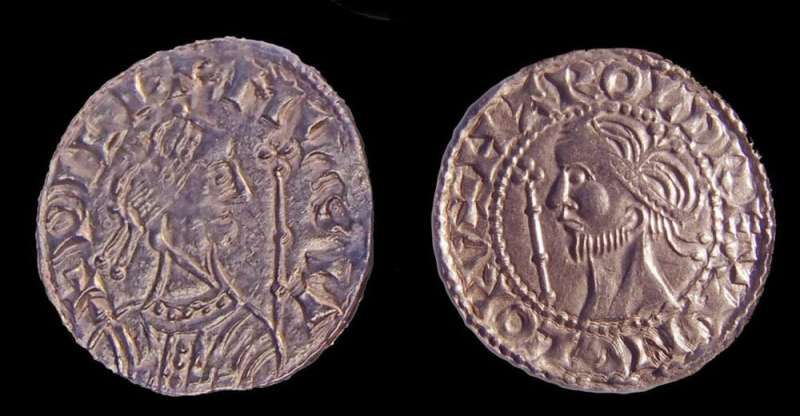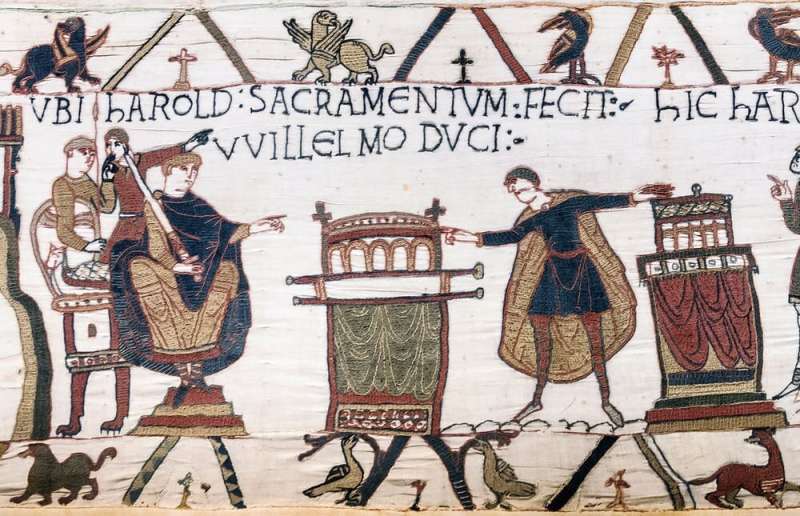Huge find of silver coins provides new clues to turbulent times after Norman Conquest of England

With their metal detectors and spades "detectorists" are a common sight in the British countryside. When their equipment bleeps, they start to dig in the hope of finding something old and valuable. They are often seen as figures of fun—in fact, the BBC shows a comedy series about a pair of such amateur archaeologists which has a cult following. But part-time treasure hunters do much of the heavy lifting when it comes to discovering antiquities buried in fields across the UK.
Two such detectorists, Lisa Grace and Adam Staples, recently uncovered a haul of more than 2,000 silver coins in Somerset in the south-west of England, dating back to the turbulent period following the Norman conquest of England in 1066.
In the years after William of Normandy defeated Harold II and took the throne, the Norman invaders were confronted by frequent rebellion. They responded by planting castles to subdue the population. The coin hoard found in the Chew Valley in Somerset dates from the years of unrest when William was establishing himself on the throne.
One of the largest hoards ever recovered from the years around 1066, it includes more than 1,000 coins minted in Harold's name and a similar number in William's. Harold had been king for only ten months at the time of his defeat and death in battle, so all the coins of Harold date from no earlier than January 1066. Some may have been minted in his name after his death, as a desperate measure by survivors to hold the regime together in the two months that elapsed between the Battle of Hastings and William's coronation. Funds were very important at moments when the succession to the throne lay in doubt.
It is certain at any rate that whoever concealed the hoard was a person of high rank, probably one of the nobility—a circle of no more than 150 landed aristocrats, many of whom were related. A coin hoard of this size may have been to pay for an army. But we might only guess whose army or whether the hoarder was a supporter or opponent of the Norman regime.
Historians have long disputed whether Harold succeeded to the throne with the approval of his predecessor and brother-in-law, the childless Edward the Confessor, or seized the throne in haste to prevent it falling to another candidate. The strongest claimants in the latter camp were Edward the Confessor's great-nephew Edgar and William of Normandy, his second cousin, who argued that Edward had promised the throne to him.
Money and power

Coin evidence assists in this debate by showing the extent to which Harold was able to control mints up and down the country. Regimes which had only a shaky hold on power were unable to control all the mints, some of which struck coins in the names of their rivals. This happened in the early years of Harold I's regime (1035-7), when mints in southern England struck coins in the name of his rival Harthacnut.
In the case of Harold II, though his legitimacy was in doubt, his control of the mints suggests a strong hold on power from the outset. Indeed the hoard is likely to provide specimens of coins minted at unrecorded mints and by previously unknown moneyers.
Historians also debate the extent to which the invasion of 1066 disrupted the operations of the Anglo-Saxon state. The presence in the hoard of a large sample of coins issued by William at the start of his reign will help shed new light on the era.
The portrait, design and text on William's coins, moreover, reveals how he wanted his subjects to see him. A coin is not only a unit of currency—it is a tool of propaganda. Harold's coins, ironically, bore the legend "PAX" (peace). It was a signal of his aspirations on becoming king.
Today Harold's coins are keenly sought by collectors, being rare and evocative our nation's story. Hoarded coins are often in fresh condition and each should command a high market value.
Rewarding hobby
Since the advent of the hobby of metal detecting in the 1970s, most hoards and single finds have been located by detectorists. Their painstaking efforts have resulted in the discovery of great treasures of recent years, including the Staffordshire Hoard and the Winfarthing pendant.
On most outings, detectorists find little or nothing. Most spend years in the hobby and never find a hoard. Thanks to a system of recording in place since the launching of the Portable Antiquities Scheme, more and more of their discoveries are now being reported.
The law requires that all finds of treasure be reported to the coroner within 14 days of discovery or of the finder's realisation that the find might be treasure as defined by the Treasure Act of 1996. Any item of precious metal more than 300 years old, any two or more gold or silver coins, or a group of base metal coins, and any associated artefacts, such as a pot in which coins are buried, is treasure as defined by the Act.
All reported treasure items are entered in the online database of the Portable Antiquities Scheme. Their details are thereby captured for the nation, even if the finds are often returned to the finder. No hoard of Norman Conquest coins on the scale of the Chew Valley hoard has come to light for many years.
It is a reminder that the passions of hobbyists frequently turn up great benefits for everyone. And it is also a reminder of England's turbulent past.
Provided by The Conversation
This article is republished from The Conversation under a Creative Commons license. Read the original article.![]()




















